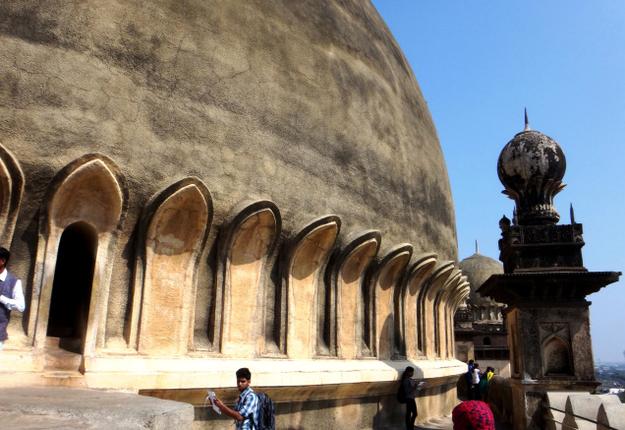
Gol Gumbaz, an elegant edifice located in a sprawling 70-acre manicured estate in Bijapur, deserves much more attention from tourists than what it is getting.
Considered the most beautiful building in the world, Taj Mahal nonchalantly dismisses other ancient constructions across the Indian subcontinent. This was evident as I recently ventured into the hinterlands of southern India to discover a magnificent medieval monument. Dominating the landscape of Bijapur in the Deccan plateau of Karnataka is India’s largest antiquated but amazing dome that is aptly called Gol Gumbaz.
Once upon a time Gol Gumbaz was the only major structure visible on the horizon of ancient Bijapur but today it is sheltered in a sprawling 70 acre manicured estate. It is passionately preserved by a small army of gardeners, guards, horticulturists and archaeologists.

Constructed with diligent dexterity this mammoth monument has a dramatic dome that snugly sits atop an equally colossal tomb. With an age tag of nearly 357 years, Gol Gumbaz is a unique mega structure of incredible India. It is a must-see for every admirer of olden-golden era of our country.
The elegant edifice equating a seven storied structure is befittingly surrounded by lush lawns under the surveillance of the Archaeology Survey of India (ASI). While some historians reckon that Gol Gumbaz is the second largest dome in the world, others deem it to be the biggest in Asia with a robust history.
Despite the disputed status it is worth admiring not merely for its sheer size but the mighty effort of translating tons of raw materials into a desirable structure. In the bygone days when mechanical paraphernalia was non-existent, pure horsepower and manpower was shrewdly applied to erect such an enduring edifice. It took away my breath as I energetically ascended the spiralling narrow stairway that can make the faint hearted pant and rant. Once on the uppermost balcony abutting the outer dome, the views of the tiny town all-round were spectacular and the inside of the dome was even more enchanting.
Curiously Gol Gumbaz (1627) and the Taj Mahal (1632) began construction during the same period by two different sultans governing independent swathes of land. Taj being in the north and the other in southern India separated by 1500 km, obviously were not aware of each other’s strategy. Although Gol Gumbaz took 29 years to complete, the Taj Mahal took 22 years to finish and the former is almost double the size with massive measurements. I pondered whether Taj Mahal has a feminine fetish, while the Gol Gumbaz is geometrically masculine. At any given time more than three million tourists visit the Taj Mahal in a year, which is double the current population of Agra. Comparatively very few travellers visit Gol Gumbaz just because it is not on the regular tourist trail and also not adequately publicised.
Gol Gumbaz is actually a mausoleum of the seventh Sultan of the Adil Shahi dynasty, his two wives, mistress Rambha, daughter and a grandson. Being an architecture marvel it is not only known for its astounding dimensions but also unique acoustic features. This edifice, without doubt, ranks among the most imposing ones in India.
The foundation of this tomb is exceptionally engineered to rest on bedrock which has prevented any unequal settlement. The width of each of the sides is equal to the height at 200 feet. The exterior diameter of the top dome is 144 feet while the interior of the structure is a single large hall, one of the largest ever built, measuring 135 feet across and 178 feet high. The four tall twirling minarets at the corners of the mega tomb are actually a series of steps leading to the top. The inside balcony is called the ‘Whispering Gallery’, because even the faintest whisper or rustle gets magnified like an echo and is truly fascinating.
Bijapur is effortlessly approachable from far and wide because of admirable driving roads. It is nearest from Sholapur at 100 km; Goa at 340 km and 530 km northwest of Bangalore but I preferred to self drive 380 km west of Hyderabad in a friend’s car and explore the town of tombs and domes. Avoiding the highways I romanced the rural roads, stopping once in a while to be smitten by wild water birds frolicking in pristine lakes and experience the rustic atmosphere.
Geographically Bijapur district consists of plain land devoid of any hills and dales. However the Deccan plateau provides enough rocky terrain to excavate stone material for construction. In an introduction to “Architecture at Beejapoor” published in 1866, Philip Meadows Taylor, an Anglo-Indian with a voracious appetite for Indian culture wrote: “Palaces, arches, tombs, cisterns, gateways, and minarets …all carved from the rich basalt rock of the locality, garlanded by creepers, broken and disjointed by peepul trees, each in its turn is a gem of art and the whole a treasury.”
I was so impressed with the Gol Gumbaz that I lingered all day walking all around for different perspectives and ruminating of its past glory. As Bijapur is still strewn with more than 300 mosques, mausoleums, tombs, domes and many ruins, I made up my mind to revisit.
Only a full week of meandering among the other monuments, which are also splendid specimens, would satisfy my hunger for relishing relics and remnants. Meanwhile the Gol Gumbaz deserves to be on the coveted list of world heritage sites and the government is making all efforts to accomplish that.
source: http://www.thehindu.com / The Hindu / Home> Features> MetroPlus / by M. Shiva Kumar / March 29th, 2015








